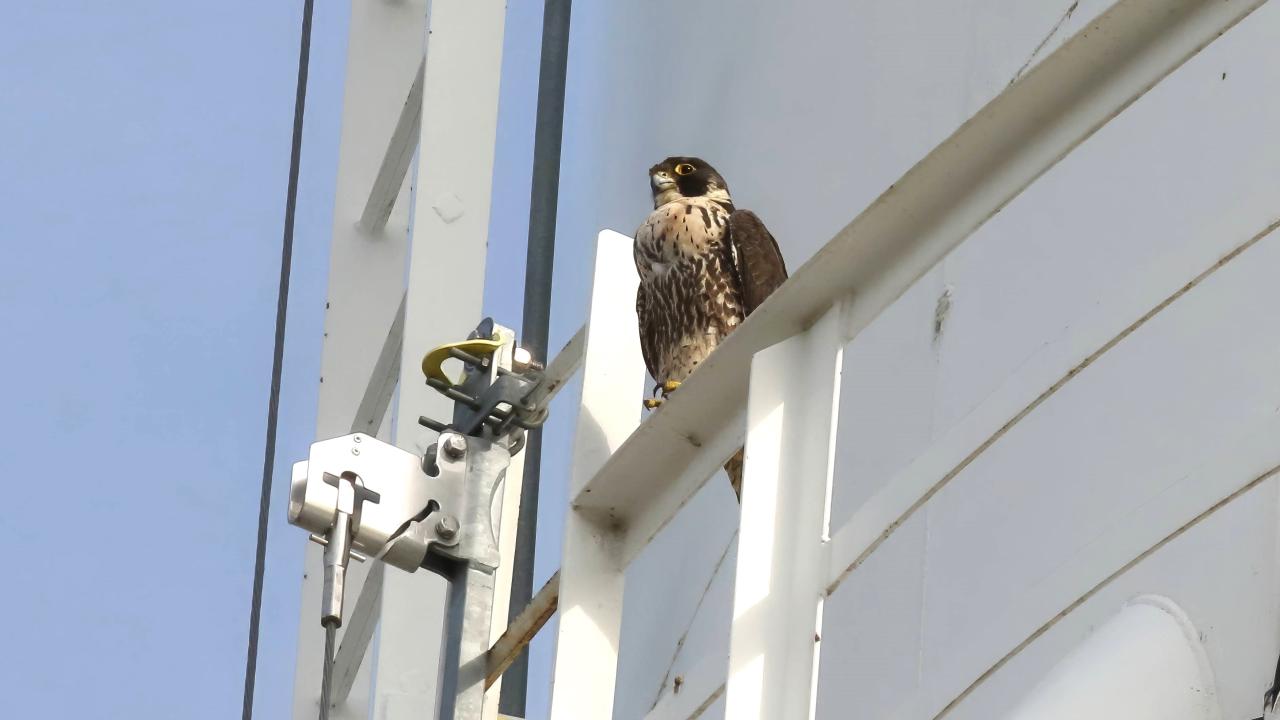
Peregrine Falcons Soaring Over Campus
Pair May Be Attempting to Nest on Water Tower for the First Time
Home is where the perch is: Two peregrine falcons may be turning the UC Davis water tower into their new nesting spot. Andrew “Andy” Engilis Jr., ornithologist and curator of the UC Davis Museum of Wildlife and Fish Biology, spotted a pair of the birds during the first week of April after hearing a loud, high-pitched “scree, scree” outside his office in the Academic Surge building.
“They have a distinctive call; I was in my office, and I could hear them calling through my window,” Engilis said. “I went outside, and they have a really distinctive shape, and I knew immediately it was a pair of peregrine falcons.”
Engilis, along with Irene Engilis who is the collections manager of the museum, have been going out nearly every day to watch the falcons. Equipped with a spotting scope and binoculars, both Andy and Irene have been keeping a close eye on the soaring birds overhead.
They discovered a great vantage point outside King Hall near the Peet’s Coffee cart where they can watch the birds in action. Dean Helene Dillard from the College of Agricultural and Environmental Sciences joined them on a bird watching expedition this week and was among the many who got an up-close look at the formidable birds.
“It’s been such a joy to be able to step out of the office for a few moments each day to check on the falcons,” said Dillard. “Watching nature in action on campus is a wonderful reminder of all the wildlife happening around us. We had a great time sharing the scope with students who were wondering what we were all staring at.”

Possible nesting site
Engilis said he’s observed one female and one male at the tower for the past two weeks. The pair’s behavior indicates they are a attempting to nest on the iconic campus water tower, which stands about 155-feet high. This is a significant discovery, according to Engilis, who found out this is the first time peregrine falcons have attempted to nest on campus.
Less than 20 miles away, peregrine falcons have nested for years at the UC Davis Medical Center in Sacramento – showing similar behavior to what’s now being seen on campus. The male looks like it has a leg band put on by researchers and Engilis wonders if one of these birds is an offspring of that Sacramento pair.
“This week, their observed behavior is restricted to one part of the tower, and we've seen them interacting, calling noisily and even copulating. Generally, birds of prey like this won't do that unless they're at a nest site,” he explained. “We see the signs they are trying to nest on the water tower, but we still have not confirmed that; after all, the nest site is over 100 feet above the ground.”
Earlier this week, after an hour of observing the female, the male suddenly flew to the tower, screeching to his mate that dinner had arrived. The male came in and bowed to the larger female eventually passing the prey (a medium-sized bird) to her. Engilis quipped that it was a “nuptial gift.” This behavior, known as courtship feeding, is another important clue that the pair intends to breed. Not only is it considered a gesture to strengthen their bond, it’s also a way for the male bird to demonstrate that he can provide food, which is especially important if they’re going to raise chicks together.
High-flying habits
Masters of the sky, peregrine falcons hunt other birds mid-air, diving at over 200 miles per hour to snatch their prey. They have powerful, long pointed wings for very fast flight.
These birds also have some unique quirks when it comes to nesting. Peregrine falcons don’t build nests in the traditional sense – instead, they lay eggs in a small hollow they've scraped into a high ledge, cliff or structure. For this pair, the UC Davis water tower could offer the ideal height and seclusion for raising their young.

If they do have a nest on the tower, Engilis believes the soon-to-be parents could produce two to three eggs. Both parents usually take turns incubating. He also thinks that the surrounding landscape of Davis with abundant agricultural land and its proximity to the Yolo Bypass Wildlife Area gives the birds a reliable food supply, which is primarily other birds. Since peregrine falcons are known for strong site fidelity, if a nesting attempt is successful, the pair could become long-term campus residents.
“If it's successful, then more than likely they'll be back year after year,” Engilis said. “It might be an annual peregrine watch.”
To ensure the birds’ safety while on campus, Dean Dillard requested that any maintenance work on the water tower be postponed until the birds leave the site.
Once listed as endangered at both the federal and state levels due to widespread pesticide use, peregrine falcons have made a remarkable recovery and are no longer considered at risk. To an avid bird watcher like Engilis, seeing the birds on campus is another part of the species’ success story. Plus, the positive impact the birds are having on the students, faculty and staff when they spot the charismatic birds is also exciting.
“You have all these students from all different majors and when we say, ‘it’s a peregrine falcon,’ they look on the scope and the first thing they say is, ‘wow;’ so that's pretty cool,” Engilis said.
Media Resources
- Andrew Engilis, UC Davis Department of Wildlife, Fish and Conservation Biology, aengilisjr@ucdavis.edu
- Tiffany Dobbyn, UC Davis College of Agricultural and Environmental Science, tadobbyn@ucdavis.edu